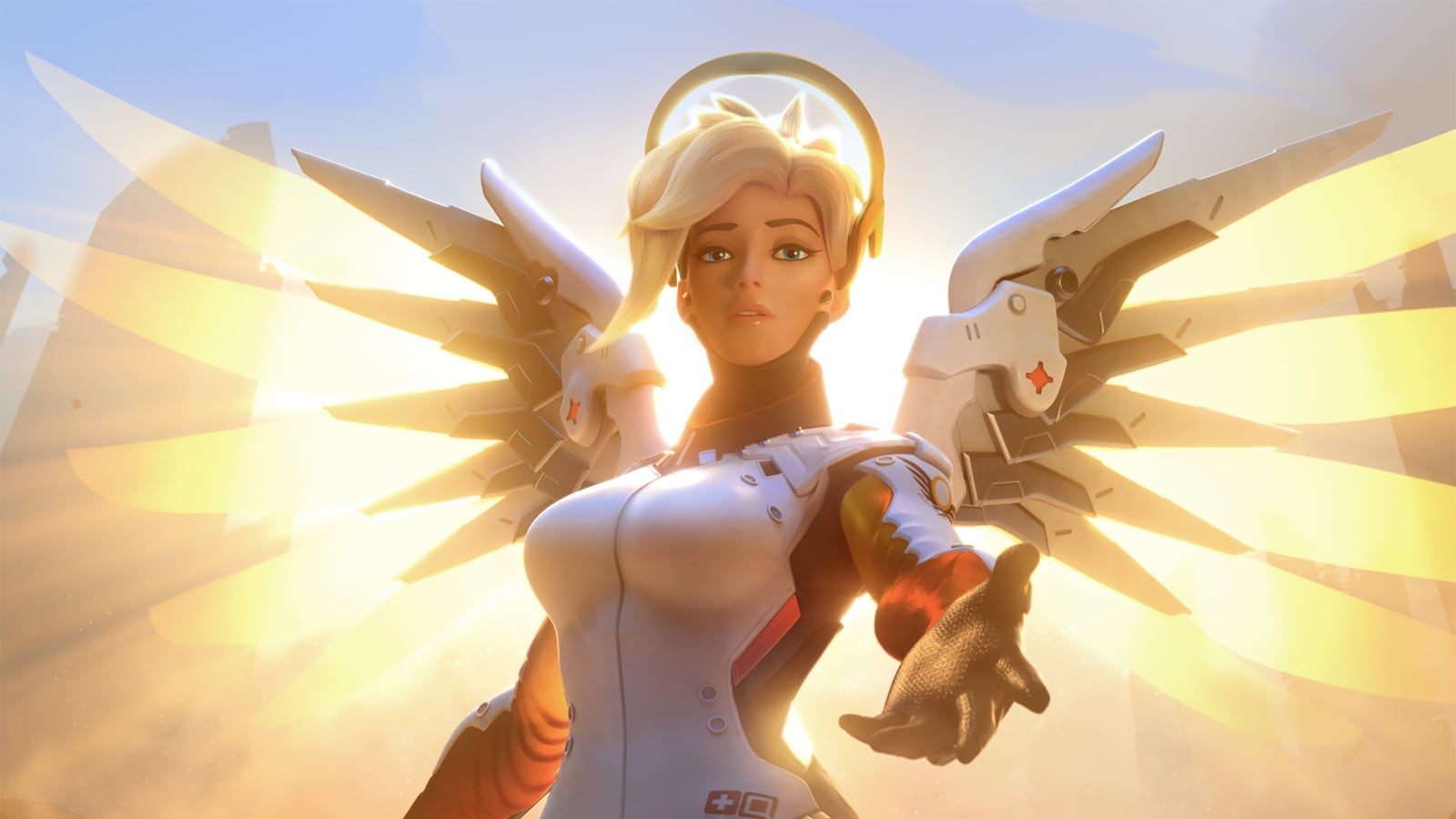By letting one step into the (virtual) shoes of a character, first-person shooters (FPS) provide an intensely immersive gaming experience. Yet those protagonists – kept relatively non-descript, so they might better serve as empty-vessel proxies for the player – often boast little personality. Which is one of the many reasons that Overwatch is such a refreshing change of pace – and why, upon hitting store shelves this past Tuesday (after a public beta period in early May), it’s quickly becoming an industry sensation.
Born from the ashes of a failed World of Warcraft-esque game dubbed Titan, Blizzard’s latest (available for the PS4, Xbox One and PC) is a multiplayer-only affair. In it, you participate against human or AI foes in six-on-six battles that take place in a variety of global locales where your objectives include capturing map positions and defending moving “payloads.” During these skirmishes, you embody one of 21 characters whom the studio has constructed with more visual and gameplay flair than any likeminded title in memory. The charisma of these avatars is established early on, in an introductory video featuring hyper-intelligent simian warrior Winston that establishes the game’s Earth-under-siege sci-fi premise – and proves to be a tour-de-force of digital animation. It’s no exaggeration to say that Winston feels like he’s leapt out of a Pixar film (or a similarly gorgeous Disney effort like Big Hero 6).

Winston’s opening scene is Overwatch’s only scripted moment, as the game itself has no narrative spine, much less an actual single-player campaign. That should, in theory, leave it feeling like merely another in a long line of elaborate, if hollow, squad-based kill-‘em-all simulators that prize tactical acumen over any sense of compelling, clever drama. And to be sure, Blizzard’s decision to forgo storytelling in the game itself, and instead to dole out peripheral plot material via online comics, is a missed opportunity, if not an outright failure of imagination. A world this richly designed should be fleshed out from within, not via external media releases.
Still, the developer has put considerable time, effort and care into delivering a rich roster of disparate future-Earth fighters and healers. With heroes and villains who’d be right at home in an animé movie or the pages of a manga, Overwatch’s line-up is an eccentric, striking group. Be it the enormity of armor-suited, hammer-swinging Reinhardt, the spectral swiftness of hooded Reaper, the cheery zippiness of fetching Tracer, the swinish perversity of big-bellied, gas-masked Roadhog, or the badassery of archetypal FPS hero Soldier: 76, there’s great stylistic range to the game’s characters. Blizzard’s three-dimensional graphical work on each is so gorgeously executed that, via a few pre-programmed gestures on the opening menus, these men and women (and machines) exude an impressive level of well-thought-out detail.
If Overwatch’s characters have differentiating exteriors, their multifaceted abilities further accentuate their distinctiveness. Split into four classes (Offense, Defense, Support, Tank), the combatants possess clear strengths and weaknesses – for instance, D.Va (a lithe girl in a giant mech suit) is powerful but slow, especially when firing, while Junkrat (a Joker-like maniac with a grenade launcher) is deadliest from a distance. Given that you can change who you are mid-contest, Overwatch encourages trying out all 21 characters, the better to gauge whose skills are ideally suited for the offensive/defensive task at hand (hint: turret-centric robot Bastion is a serious heavyweight).

Moreover, because you play as part of a six-person crew, determining which characters operate well together is key. In that regard, Overwatch is most fun when played with friends, since you can then concoct a line-up – say, a sniper, two healers, two tanks, and three offensive fighters – in which various players’ abilities complement each other. Such planning is vital for success if competing against human or AI adversaries (at least on the most difficult setting), and is further complicated by the location of your match, as some arenas are more conducive to full-frontal assaults, and others encourage a cagier, more cunning approach.
From Hollywood to Egypt, Russia, England, China, Nepal and beyond, the game’s international arenas have been conceived with the same attention to detail and personality as their inhabitants. Visually and structurally dissimilar, and yet all imbued with a bright, colorful vivacity, Overwatch’s battlegrounds are a joy to both look at and explore – as well as to memorize, as learning the finest hiding spots, perches and navigation routes is a necessary component of defeating one’s opponents (many of whom have been playing since the beta went live, and are thus already adept at using their surroundings to their advantage). While the game is easy to simply pick up and play, it requires substantial trial-and-error practice to master.
Blizzard has embellished the primary action with level upgrades and “loot boxes” – which are either earned, or can be purchased through in-game micro-transactions – that reward users with alternate outfits and collectibles. Those elements are largely superfluous, but Overwatch further stokes competition through post-match statistical tallies that rank one’s performance, as well as via its selection of a battle’s standout performer, who’s bestowed with a quick highlight reel of their most impressively murderous stretch – touches that are bound to heighten rivalries between friends-at-arms.
Considering the fluid precision and strategic depth of its gameplay, Overwatch’s multiplayer FPS mayhem seems ideally suited for team-oriented eSports (i.e. professional Major League Gaming) tournaments. What truly marks it as a groundbreaking effort, however, isn’t just its expert execution but its very concept – one that, in terms of characters, milieus, visuals, and overarching emphasis on the equal usefulness of contrasting powers, shrewdly champions the virtues of diversity. It’s a game that recognizes, and celebrates, the notion that triumph is often accomplished when dissimilar individuals come together for a common cause, using each other’s unique assets to help mask each other’s shortcomings. Whether you’re a freeze gun-wielding girl, a throwing star-hurling ninja, a sharp-shooting desperado, or a rocket-launching Valkyrie, you’re always best off in Overwatch when you’re most lethally embracing, and exploiting, your differences.






